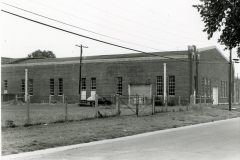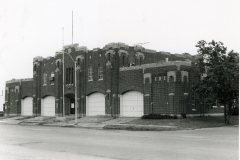| Address: | 301 West Main, Watonga, Oklahoma | County: | Blaine |
| Started: | November 1935 | Completed: | January 1937 |
| Agencies: | WPA | NRHP: | May 20, 1994 |
Current Usage:
Description:
By mid-summer of 1935 the Watonga City Council had submitted several proposals for WPA projects, including a new school building, a swimming pool/playground, improvements and new buildings for the fairgrounds, and an armory building, which was projected to cost $30,000. An armory site on West Main Street was purchased with funds from a bond election. Thus, the city’s share of the cost of the armory was provided in land. WPA crews began clearing the armory site on November 7, 1935. A short project expanded into a long one, however, and crews began working staggered shifts (two per day) in order to expedite the process. Nevertheless, in November of 1936 the armory was still unfinished. Work continued into 1937, and on January 28, the day of dedication, the wood-block floor was not completely finished. On January 28, three thousand people celebrated the opening of the armory, with Gen. Key, state WPA director, and many other dignitaries present to participate in the laying of the cornerstone. The guests enjoyed an afternoon program including a military band concert and concluding with a dance in the new armory. WPA projects in 1935-1937 propped up the sagging rural economy of Blaine County. By May of 1936 the WPA had expended $125,524 throughout the county. The WPA’s cost on the armory project was $51,307.40 (with the city contributing only the site). With the exception of the farm-to-market road project and the new school, the federal government invested more in the armory than in any other building project in the county. In human terms, tens of thousands of person-hours of labor went into the armory’s construction. The project employed from thirty to fifty men, working staggered shifts (two six-hour shifts per day), in order to provide maximum employment and to expedite the job. These figures testify to the labor-intensive nature of WPA projects, which were designed to provide as much work as possible for those on relief rolls. Most of the hours were consumed in hand labor (bricklaying and pouring concrete), and in installing a wood-block floor in the 86′ by 125′ drill room (more than 100,000 wood blocks were cut, primed, set in asphalt, sanded, oiled, and polished in patterned sections). A concrete floor would have sufficed, but ample time and labor were available to create a complicated design.
Upon completion, the Watonga Armory became the home of the Headquarters Battery and Combat Train. 189th Field Artillery, 45th Infantry Division, Oklahoma National Guard. [1]
Sources:
Supported Documents:
- National Register of Historic Places
- Oklahoma Landmarks Inventory Database
- Oklahoma Department of Environmental Quality Survey





Leave a Reply